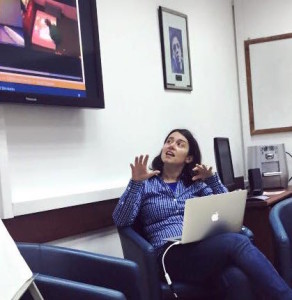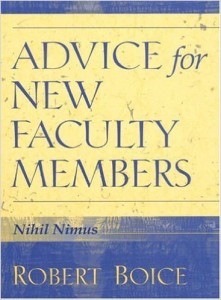Note: This post generated a fair bit of discussion on Facebook and I’m adding (as block quotes) a few of the comments since this was first posted.
Recently, I’ve had a number of conversations where I’ve been asked whether I feel like I belong in a traditional Computer Science department. Given that my whole academic career has been centered on Computer Science (from declaring it as my major upon entry into undergrad to my current faculty position at U of M), I can definitely say that it is my community of practice. I get my funding from NSF CISE, I publish almost exclusively in ACM conferences, I teach only Computer Science courses — where else would I belong? But, I also realize that it is a salient question for many colleagues in my field, as HCI1 researchers are more and more likely to find their home in iSchools, Design, Psychology, Cognitive Science, and Human Factors programs. In this post, I want to articulate why I am of the opinion that Computer Science department and colleges/schools of Computing should be doing more to recruit and retain Computer Scientists trained in HCI.
Meaningful Evaluations – Most Computer Scientists develop algorithms and systems with the idea of improving upon some existing baseline. While some metrics of success may be straight-forward to articulate (e.g., time to run, prediction accuracy), many evaluations may require consideration of a richer and more nuanced set of factors. In the end, the most meaningful metrics look at how a system or algorithm performs in service of people. HCI is the branch of Computer Science where researchers have the training to plan and perform evaluations that lead to more meaningful, ecologically-valid comparisons. More importantly, Computer Scientists trained in HCI also have the fundamental understanding of the development process that allows them to carry out studies that lead not only to summative comparisons, but also to specific implications for how systems and algorithms can be improved in order to perform better in real-world evaluations. For example, an HCI evaluation may reveal the relative consequences of different types of algorithm accuracy errors, leading to an understanding of the kinds of improvements to accuracy that have most significant effects.
I agree with all the above, and would add two things: 1) some HCI work is more oriented around systems building, and that is more naturally centered in a CS department. Sometimes it is very technical application of existing techniques and sometimes it is new techniques – but this kind of work readily live in multiple places. 2) I think the best traditional technical work happens when it is done with close work with stakeholders. Even theoretical work can be stronger when considering the real needs and problems of users. Developing that understanding is best done in close proximity to them – thus integrating HCI into CS can help that process.
-Prof. Ben Bederson, University of Maryland
Diversity – Computer Science has a well-documented diversity problem, which has been growing in recent years. It has also been documented that both women and minorities are more interested in applying STEM to culturally-relevant broader impact contexts. Thus, it’s not surprising that of the few women and minority Computer Scientists who do make it through grad school, many choose focus on HCI. While CS departments should be making an extra effort to recruit and retain qualified women and minority candidates, my personal experience with faculty hiring is the opposite. I frequently see that given two candidates with similar training and publication records (in terms of venues and quantity), women are more likely to end up in iSchools while men are more likely to stay in Computer Science. If this trend is real, it is bad for CS because it is a lost opportunity to increase diversity. The problem is two-fold. First, a CS department may not make an offer to a qualified candidate due to a narrow definition of what constitutes technical work or a contribution to Computer Science. Second, even when an offer is made, the candidate may perceive a department culture that is unfriendly towards HCI work and elect to accept a competing iSchool offer (despite the fact that iSchools may pay less and have a higher teaching load).2 The New York Times recently ran an article showing that as more women go into specific field, salaries in that field decrease. We don’t know the mechanism by which this happens, but my worry is that this is the pattern that is emerging here. Of course, there could be a number of alternative explanations, but I think that it can’t hurt to collectively keep an eye on this.
Learner-Centered Teaching – There are many CS courses that do not require any specific area specialization to teach, most notably introductory classes to CS, computing courses for non-majors, and freshmen seminars. There are many reasons why HCI faculty may be particularly well-suited to achieve excellent outcomes in such courses: (1) there is a clear transfer of skills between designing user-centered systems and designing learner-centered curricula, (2) HCI research can be presented in these courses as a counter-example to popular misperceptions of Computer Science as an asocial, solitary pursuit, and (3) HCI faculty may provide stereotype-threat-breaking role models, given the larger proportion of women and minority faculty in HCI. In my opinion, Computer Science departments with a strong undergraduate education mandate should be actively seeking to recruit Computer Science HCI faculty.
I disagree with “there is a clear transfer of skills between designing user-centered systems and designing learner-centered curricula.” There’s a potential for transfer, but I’ve met some HCI (and even Ed) researchers who are really awful teachers. And I don’t like the idea of giving all other CS teachers an excuse, e.g., “I don’t do HCI, so I don’t have the background to be a good teacher.”
-Prof. Mark Guzdial, Georgia Tech
I wanted to keep it to these three top reasons, but there are a number of other ways that Computer Science as a whole benefits from the specific skills that Computer Scientists trained in HCI bring to the table, including more interdisciplinary work, broader impact of research, and considerations of critical issues (e.g., bias) at design stage.
If you are currently in a Computer Science department and you agree with my arguments, there are a few clear steps you can take to help your department: (1) advocate for soliciting and hiring Computer Science candidates trained in HCI, (2) confront and question arguments against hiring a candidate that focus on vague concern of “not being technical enough” (especially, when candidate is trained in Computer Science and publishes in computing venues), and (3) articulate narratives of Computer Science that include rather than exclude HCI.
1. I use HCI (Human-Computer Interaction) here as the broader discipline, but this includes many related disciplines including HRI, Game Studies, Social Computing, Mobile & Ubiquitous Computing, etc.
2. I am uncomfortable calling out specific schools and contrasting specific people. I am basing this entirely from my personal experience on the job market 3 years ago. I received 3 offers from iSchools and 3 offers from CS departments. Your mileage may vary.



